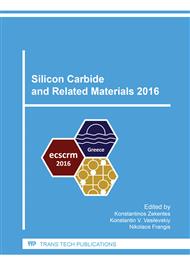[1]
A. J. Lelis, R. Green, D. B. Habersat, and M. El, Basic Mechanisms of Threshold-Voltage Instability and Implications for Reliability Testing of SiC MOSFETs, IEEE Trans. Electron Devices, 62 (2015) 316-323.
DOI: 10.1109/ted.2014.2356172
Google Scholar
[2]
J. Rozen, S. Dhar, S. K. Dixit, V. V. Afanas'ev, F. O. Roberts, H. L. Dang, S. Wang, S. T. Pantelides, J. R. Williams, and L. C. Feldman, Increase in oxide hole trap density associated with nitrogen incorporation at the SiO2/SiC interface, J. Appl. Phys. 103 (2008).
DOI: 10.1063/1.2940736
Google Scholar
[3]
D. B. Habersat and A. J. Lelis, Improved Observation of SiC/SiO2 Oxide Charge Traps Using MOS C–V, Mater. Sci. Forum 679 (2011) 366-369.
DOI: 10.4028/www.scientific.net/msf.679-680.366
Google Scholar
[4]
J. Rozen, S. Dhar, M. E. Zvanut, J. R. Williams, and L. C. Feldman, Density of interface states, electron traps, and hole traps as a function of the nitrogen density in SiO2 on SiC, J. Appl. Phys. 105 (2009) 124506.
DOI: 10.1063/1.3131845
Google Scholar
[5]
O. Dai, Y. Hiroshi, O. Yuki, H. Tomoaki, U. Yukiharu, and F. Takashi, Investigation of Near-Interface Traps Generated by NO Direct Oxidation in C-face 4H-SiC Metal–Oxide–Semiconductor Structures, Appl. Phys. Express 2 (2009) 021201.
DOI: 10.1143/apex.2.021201
Google Scholar
[6]
A. Chanthaphan, T. Hosoi, S. Mitani, Y. Nakano, T. Nakamura, T. Shimura, and H. Watanabe, Investigation of unusual mobile ion effects in thermally grown SiO2 on 4H-SiC(0001) at high temperatures, Appl. Phys. Lett. 100 (2012) 252103.
DOI: 10.1063/1.4729780
Google Scholar
[7]
D. Haasmann, H. A. Moghadam, J. Han, A. Aminbeidokhti, A. Iacopi, and S. Dimitrijev, Dipole Type Behavior of NO Grown Oxides on 4H–SiC, Mater. Sci. Forum 858 (2016) 453-546.
DOI: 10.4028/www.scientific.net/msf.858.453
Google Scholar
[8]
W. Li, J. Zhao, and D. Wang, Structural and electronic properties of the transition layer at the SiO2/4H-SiC interface, AIP Advances 5 (2015) 017122.
DOI: 10.1063/1.4906257
Google Scholar
[9]
F. Devynck, A. Alkauskas, P. Broqvist, and A. Pasquarello, Charge transition levels of carbon-, oxygen-, and hydrogen-related defects at the SiC/SiO2 interface through hybrid functionals, Phys. Review B 84 (2011) 235320.
DOI: 10.1103/physrevb.84.235320
Google Scholar
[10]
P. Jamet, S. Dimitrijev, and P. Tanner, Effects of nitridation in gate oxides grown on 4H-SiC, " J. Appl. Phys. 90 (2001) 5058-5063.
DOI: 10.1063/1.1412579
Google Scholar
[11]
H. A. Moghadam, S. Dimitrijev, H. Jisheng, D. Haasmann, and A. Aminbeidokhti, Transient-Current Method for Measurement of Active Near-Interface Oxide Traps in 4H-SiC MOS Capacitors and MOSFETs, IEEE Trans. Electron Devices, 62 (2015) 2670-2674.
DOI: 10.1109/ted.2015.2440444
Google Scholar


